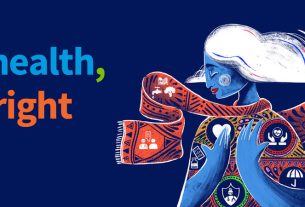Joel Wakefield isn’t just an armchair epidemiologist. His interest in tracking the spread of covid is personal.
The 58-year-old lawyer who lives in Phoenix has an immunodeficiency disease that increases his risk of severe outcomes from covid-19 and other infections. He has spent lots of time since 2020 checking state, federal, and private sector covid trackers for data to inform his daily decisions.
“I’m assessing ‘When am I going to see my grandkids? When am I going to let my own kids come into my house?’” he said.
Many Americans have moved on from the pandemic, but for the millions who are immunocompromised or otherwise more vulnerable to covid, reliable data remains important in assessing safety.
“I don’t have that luxury to completely shrug it off,” Wakefield said.
The federal government’s public health emergency that’s been in effect since January 2020 expires May 11. The emergency declaration allowed for sweeping changes in the U.S. health care system, like requiring state and local health departments, hospitals, and commercial labs to regularly share data with federal officials.
But some shared data requirements will come to an end and the federal government will lose access to key metrics as a skeptical Congress seems unlikely to grant agencies additional powers. And private projects, like those from The New York Times and Johns Hopkins University, which made covid data understandable and useful for everyday people, stopped collecting data in March.
Public health legal scholars, data experts, former and current federal officials, and patients at high risk of severe covid outcomes worry the scaling back of data access could make it harder to control covid.
There have been improvements in recent years, such as major investments in public health infrastructure and updated data reporting requirements in some states. But concerns remain that the overall shambolic state of U.S. public health data infrastructure could hobble the response to any future threats.
“We’re all less safe when there’s not the national amassing of this information in a timely and coherent way,” said Anne Schuchat, former principal deputy director of the Centers for Disease Control and Prevention.
A lack of data in the early days of the pandemic left federal officials, like Schuchat, with an unclear picture of the rapidly spreading coronavirus. And even as the public health emergency opened the door for data-sharing, the CDC labored for months to expand its authority.
Eventually, more than a year into the pandemic, the CDC gained access to data from private health care settings, such as hospitals and nursing homes, commercial labs, and state and local health departments.
CDC officials have been working to retain its authority over some information, such as vaccination records, said Director Rochelle Walensky.
Walensky told the U.S. House in February that expanding the CDC’s ability to collect public health data is critical to its ability to respond to threats.
“The public expects that we will jump on things before they become public health emergencies,” she later told KFF Health News. “We can’t do that if we don’t have access to data.”
The agency is negotiating information-sharing agreements with dozens of state and local governments, Walensky said, as well as partnering with the Centers for Medicare & Medicaid Services. It is also lobbying for the legal power to access data from both public and private parts of the health care system. The hospital data reporting requirement was decoupled from the health emergency and is set to expire next year.
But it’s an uphill battle.
“Some of those data points we may not have anymore,” Walensky said, noting how access to covid test results from labs will disappear. That data became a less precise indicator as people turned to at-home testing.
Moving forward, Walensky said, the CDC’s covid tracking will resemble its seasonal flu surveillance, which uses information from sample sites to establish broad trends. It’ll offer a less granular view of how covid is spreading, which experts worry could make it harder to notice troubling new viral variants early.
Overall, federal courts — including the U.S. Supreme Court — have not been supportive of expanded public health powers in recent years. Some issued rulings to block mask mandates, pause mandatory covid vaccination requirements, and end the nationwide eviction moratorium.
Such power limits leave the CDC with its “utterly dysfunctional, antiquated” data collection system, said Lawrence Gostin, director of the O’Neill Institute for National and Global Health Law at Georgetown University. It’s like a “mosaic,” he said, in which states and territories collect data their own way and decide how much to share with federal officials.
Although covid numbers are trending down, the CDC still counts thousands of new infections and hundreds of new deaths each week. More than 1,000 Americans are also hospitalized with covid complications daily.
“When we stop looking, it makes it all more invisible,” Gostin said. “Covid knowledge and awareness is going to melt into the background.”
State and local public health officials are generally willing to share data with federal agencies, but they often run into legal hurdles that prevent them from doing so, said Marcus Plescia, chief medical officer of the Association of State and Territorial Health Officials.
It will take a lot of work to loosen state restrictions on public health data. And the political will may be lacking, considering many jurisdictions have rolled back public health powers in recent years. Until rules change, the CDC’s power to help states is limited, Plescia said.
“Their hands are tied a little bit in how much they can do,” he said.
Public health officials rely on data to target interventions and track how well they’re working. A lack of information can create blind spots that exacerbate poor outcomes for high-risk populations, said Denise Chrysler, a senior adviser for the Network for Public Health Law.
“If you don’t have the data, you can’t locate who you’re failing to serve. They’re going to fall between the cracks,” she said.
The lack of covid data broken down by race and ethnicity in the early days of the pandemic obscured the outsize impact covid had on marginalized groups, such as Black and Hispanic people, Chrysler said. Some states, like New Jersey and Arizona, issued rules to mandate the collection of race and ethnicity data for covid, but they were temporary and tied to state emergency declarations, she said.
Inconsistent local data precipitated the end of privately run projects that supplemented government resources.
The available data researchers could pull from “was just terrible,” said Beth Blauer, associate vice provost for public sector innovation at Johns Hopkins, who helped launch its dashboard. The decision to end the program was practical.
“We were relying on publicly available data sources, and the quality had rapidly eroded in the last year,” she said.
The fast collapse of the data network also raises questions about state and local agencies’ long-term investments in tracking covid and other threats.
“I wish that we had a set of data that would help us guide personal decision-making,” Blauer said. “Because I’m still fearful of a pandemic that we don’t really know a ton about.”
To Schuchat, formerly of the CDC, there’s a lot of ground to regain after years of underinvestment in public health, long before the covid pandemic — and high stakes in ensuring good data systems.
The CDC’s detection of a vaping-related lung illness in 2019 was recognized after case reports from a hospital in Wisconsin, she said. And she attributed the nation’s slow reaction to the opioid crisis to poor access to emergency room data showing a troubling trend in overdoses.
“We’re much better when we detect things before there’s an emergency,” Schuchat said. “We can prevent major emergencies from happening.”



